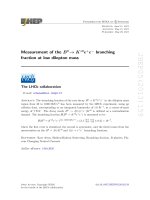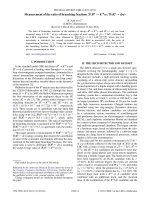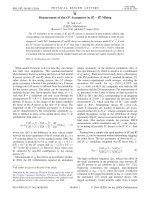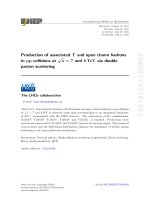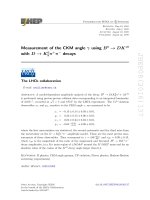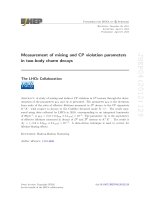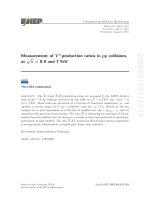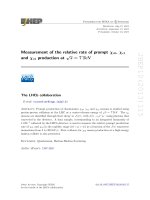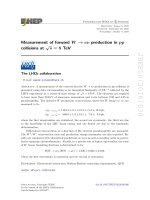DSpace at VNU: Measurement of psi(2S) meson production in pp collisions at root s = 7 TeV
Bạn đang xem bản rút gọn của tài liệu. Xem và tải ngay bản đầy đủ của tài liệu tại đây (1006.7 KB, 12 trang )
Eur. Phys. J. C (2012) 72:2100
DOI 10.1140/epjc/s10052-012-2100-4
Regular Article - Experimental Physics
Measurement
of ψ(2S) meson production in pp collisions
√
at s = 7 TeV
The LHCb Collaboration
CERN, 1211 Geneva 23, Switzerland
Received: 11 April 2012 / Revised: 22 May 2012 / Published online: 10 August 2012
© CERN for the benefit of the LHCb collaboration 2012. This article is published with open access at Springerlink.com
Abstract The differential cross-section for the inclusive
√
production of ψ(2S) mesons in pp collisions at s = 7 TeV
has been measured with the LHCb detector. The data sample corresponds to an integrated luminosity of 36 pb−1 .
The ψ(2S) mesons are reconstructed in the decay channels ψ(2S) → μ+ μ− and ψ(2S) → J /ψπ + π − , with the
J /ψ meson decaying into two muons. Results are presented
both for promptly produced ψ(2S) mesons and for those
originating from b-hadron decays. In the kinematic range
pT (ψ(2S)) ≤ 16 GeV/c and 2 < y(ψ(2S)) ≤ 4.5 we measure
σprompt ψ(2S)
= 1.44 ± 0.01 (stat) ± 0.12 (syst)+0.20
−0.40 (pol) µb,
σb ψ(2S) = 0.25 ± 0.01 (stat) ± 0.02 (syst) µb,
where the last uncertainty on the prompt cross-section is due
to the unknown ψ(2S) polarization. Recent QCD calculations are found to be in good agreement with our measurements. Combining the present result with the LHCb J /ψ
measurements we determine the inclusive branching fraction
B b → ψ(2S)X
= 2.73 ± 0.06 (stat) ± 0.16 (syst) ± 0.24 (BF) × 10−3 ,
where the last uncertainty is due to the B(b → J /ψX),
B(J /ψ → μ+ μ− ) and B(ψ(2S) → e+ e− ) branching fraction uncertainties.
1 Introduction
Since its discovery, heavy quarkonium has been one of
the most important test laboratories for the development
e-mail:
of QCD at the border between the perturbative and nonperturbative regimes, resulting in the formulation of the nonrelativistic QCD (NRQCD) factorisation formalism [1, 2].
However, prompt production studies carried out at the Tevatron collider in the early 1990s [3] made clear that NRQCD
calculations, based on the leading-order (LO) colour-singlet
model (CSM), failed to describe the absolute value and
the transverse momentum (pT ) dependence of the charmonium production cross-section and polarization data. Subsequently, the inclusion of colour-octet amplitudes in the
NRQCD model has reduced the discrepancy between theory and experiment, albeit at the price of tuning ad hoc
some matrix elements [2]. On the other hand, recent computations of the next-to-leading-order (NLO) and next-to-nextto-leading-order (NNLO) terms in the CSM yielded predictions in better agreement with experimental data, thus resurrecting interest in the colour-singlet framework. Other models have been proposed and it is important to test them in the
LHC energy regime [4, 5].
Heavy quarkonium is also produced from b-hadron
decays. It can be distinguished from promptly produced
quarkonium exploiting its finite decay time. QCD predictions are based on the Fixed-Order-Next-to-LeadingLog (FONLL) approximation for the bb¯ production crosssection. The FONLL approach improves NLO results by
resumming pT logarithms up to the next-to-leading order
[6, 7].
To allow a comparison with theory, promptly produced
quarkonia should be separated from those coming from
b-hadron decays and from those cascading from higher
mass states (feed-down). The latter contribution strongly affects J /ψ production and complicates the interpretation of
prompt J /ψ data. On the other hand, ψ(2S) charmonium
has no appreciable feed-down from higher mass states and
therefore the results can be directly compared with the theoretical predictions, making it an ideal laboratory for QCD
studies.
This paper presents a measurement of the ψ(2S) meson
production cross-section in pp collisions at the centre-of-
Page 2 of 12
√
mass energy s = 7 TeV. The data were collected by the
LHCb experiment in 2010 and correspond to an integrated
luminosity of 35.9 ± 1.3 pb−1 . The analysis is similar to
that described in Ref. [8] for the J /ψ production studies; in
particular, the separation between promptly produced ψ(2S)
and those originating from b-hadron decays is based on the
reconstructed decay vertex information. Two decay modes
of the ψ(2S) meson have been used: ψ(2S) → μ+ μ−
and ψ(2S) → J /ψπ + π − followed by J /ψ → μ+ μ− . The
J /ψπ + π − mode, despite a larger background and a lower
reconstruction efficiency, is used to cross-check and average
the results, and to extend the accessible phase space. The
production of ψ(2S) meson at the LHC has also been studied at the CMS experiment [9].
2 The LHCb detector and data sample
The LHCb detector is a forward spectrometer [10], designed
for precision studies of CP violation and rare decays of
b- and c-hadrons. Its tracking acceptance covers approximately the pseudorapidity region 2 < η < 5. The detector
elements are placed along the beam line of the LHC starting
with the vertex detector, a silicon strip device that surrounds
the pp interaction region and is positioned at 8 mm from
the beams during collisions. It provides precise measurements of the positions of the primary pp interaction vertices
and decay vertices of long-lived hadrons, and contributes
to the measurement of particle momenta. Other detectors
used for momentum measurement include a large area silicon strip detector located before a dipole magnet of approximately 4 Tm, and a combination of silicon strip detectors and straw drift chambers placed downstream. Two ring
imaging Cherenkov detectors are used to identify charged
hadrons. Further downstream an electromagnetic calorimeter is used for photon and electron detection, followed by
a hadron calorimeter. The muon detection consists of five
muon stations equipped with multi-wire proportional chambers, with the exception of the centre of the first station using
triple-GEM detectors.
The LHCb trigger system consists of a hardware level,
based on information from the calorimeter and the muon
systems and designed to reduce the frequency of accepted
events to a maximum of 1 MHz, followed by a software
level which applies a full event reconstruction. In the first
stage of the software trigger a partial event reconstruction
is performed. The second stage performs a full event reconstruction to further enhance the signal purity.
The analysis uses events selected by single muon or
dimuon triggers. The hardware trigger requires one muon
candidate with a pT larger than 1.4 GeV/c or two muon candidates with a pT larger than 560 MeV/c and 480 MeV/c.
In the first stage of the software trigger, either of the two
Eur. Phys. J. C (2012) 72:2100
following selections is required. The first selection confirms
the single muon trigger candidate and applies a harder cut
on the muon pT at 1.8 GeV/c. The second selection confirms the dimuon trigger candidate by requiring the opposite charge of the two muons and adds a requirement to the
dimuon mass to be greater than 2.5 GeV/c2 . In the second
stage of the software trigger, two selections are used for the
ψ(2S) → μ+ μ− mode. The first tightens the requirement
on the dimuon mass to be greater than 2.9 GeV/c2 and it
applies to the first 8 pb−1 of the data sample. Since this selection was subsequently prescaled by a factor five, for the
largest fraction of the remaining data (28 pb−1 ) a different
selection is used, which in addition requires a good quality
primary vertex and tracks for the dimuon system. For the
J /ψπ + π − mode only one selection is used which requires
the combined dimuon mass to be in a ±120 MeV/c2 mass
window around the nominal J /ψ mass. To avoid that a few
events with high occupancy dominate the software trigger
CPU time, a set of global event cuts is applied on the hit
multiplicity of each subdetector used by the pattern recognition algorithms, effectively rejecting events with a large
number of pile-up interactions.
The simulation samples used for this analysis are based
on the P YTHIA 6.4 generator [11] configured with the parameters detailed in Ref. [12]. The prompt charmonium production processes activated in P YTHIA are those from the
leading-order colour-singlet and colour-octet mechanisms.
Their implementation and the parameters used are described
in detail in Ref. [13]. The E VT G EN package [14] is used to
generate hadron decays and the G EANT 4 package [15] for
the detector simulation. The QED radiative corrections to
the decays are generated using the P HOTOS package [16].
3 Signal yield
The two modes, ψ(2S) → μ+ μ− and ψ(2S) → J /ψπ + π − ,
have different decay and background characteristics, therefore dedicated selection criteria have been adopted. The optimisation of the cuts has been performed using the simulation. A common requirement is that the tracks, reconstructed
in the full tracking system and passing the trigger requirements, must be of good quality (χ 2 /ndf < 4, where ndf is
the number of degrees of freedom) and share the same vertex with fit probability P (χ 2 ) > 0.5 % (ψ(2S) → μ+ μ− )
and P (χ 2 ) > 5 % (ψ(2S) → J /ψπ + π − ). A cut pT >
1.2 GeV/c is applied for the muons from the ψ(2S) →
μ+ μ− decay. For muons from J /ψ(μ+ μ− )π + π − we
require a momentum larger than 8 GeV/c and pT >
0.7 GeV/c. Finally the rapidity of the reconstructed ψ(2S)
is required to satisfy the requirement 2 < y ≤ 4.5.
The ψ(2S) → μ+ μ− invariant mass spectrum for all selected candidates is shown in Fig. 1(a). The fitting function
Eur. Phys. J. C (2012) 72:2100
Page 3 of 12
is a Crystal Ball [17] describing the signal plus an exponential function for the background. In total 90600 ± 690 signal
candidates are found in the pT range 0–12 GeV/c. The mass
resolution is 16.01 ± 0.12 MeV/c2 and the Crystal Ball parameters that account for the radiative tail are obtained from
the simulation.
For the ψ(2S) → J /ψ(μ+ μ− )π + π − decay, both pions are required to have pT > 0.3 GeV/c and the sum of
the two-pion transverse momenta is required to be larger
than 0.8 GeV/c. The quantity Q = M(J /ψπ + π − ) −
M(π + π − ) − M(μ+ μ− ) is required to be ≤200 MeV/c2
and to improve the mass resolution the dimuon invariant
mass Mμ+ μ− is constrained in the fit to the nominal J /ψ
mass value [18]. Finally, both J /ψ and ψ(2S) candidates
must have pT > 2 GeV/c. The invariant mass spectrum is
shown in Fig. 1(b) for all selected candidates. For this decay mode the peak is described by the sum of two Crystal Ball functions for the signal plus an exponential function for the background. The number of signal candidates is
12300 ± 200, the mass resolution is 2.10 ± 0.07 MeV/c2 ,
and the Crystal Ball tail parameters are fixed to the values
obtained from the simulation.
The fits are repeated in each ψ(2S) pT bin to obtain the
number of signal and background candidates for both decays.
4 Cross-section measurement
The differential cross-section for the inclusive ψ(2S) meson
production is computed from
Nsig (pT )
dσ
(pT ) =
dpT
L tot (pT )B pT
(1)
where dσ/dpT is the average cross-section in the given
pT bin, integrated over the rapidity range 2 < y ≤ 4.5,
Nsig (pT ) is the number of signal candidates determined
from the mass fit for the decay under study, tot (pT ) is
the total detection efficiency including acceptance and trigger effects, B denotes the relevant branching fraction and
pT is the bin size. All branching fractions are taken
from Ref. [18]: B(ψ(2S) → e+ e− ) = (7.72 ± 0.17) ×
10−3 , B(ψ(2S) → J /ψπ + π − ) = (33.6 ± 0.4) × 10−2 and
B(J /ψ → μ+ μ− ) = (5.93 ± 0.06) × 10−2 . Assuming lepton universality, we use the dielectron branching fraction
B(ψ(2S) → e+ e− ) in Eq. (1), since B(ψ(2S) → μ+ μ− ) is
less precisely known. L is the integrated luminosity, which
is calibrated using both Van der Meer scans [19, 20] and a
beam-profile method [21]. A detailed description of the two
methods is given in Ref. [22]. The knowledge of the absolute
luminosity scale is used to calibrate the number of tracks in
the vertex detector, which is found to be stable throughout
the data taking period and can therefore be used to monitor
the instantaneous luminosity of the entire data sample. The
integrated luminosity of the data sample used in this analysis
is determined to be 35.9 pb−1 .
The total efficiency, tot (pT ), is a product of three contributions: the geometrical acceptance, the combined detection, reconstruction and selection efficiency, and the trigger efficiency. Each contribution has been determined using simulated events for the two decay channels. In order
to evaluate the trigger efficiency, the trigger selection algorithms used during data taking are applied to the simulation.
The total efficiency vs. pT for the two channels, assuming
the ψ(2S) meson unpolarized, is shown in Fig. 2. Extensive studies on dimuon decays of prompt J /ψ [8], ψ(2S)
and Υ [23] mesons have shown that the total efficiency in
the LHCb detector depends strongly on the initial polarization state of the vector meson. This effect is absent for
ψ(2S) mesons coming from b-hadron decays. In fact for
these events the natural polarization axis is the ψ(2S) meson flight direction in the b-hadron rest frame, while the
ψ(2S) meson appears unpolarized along its flight direction
in the laboratory. Simulations [8] and measurements from
CDF [24] confirm this. We do not measure the ψ(2S) meson polarization but we assign a systematic uncertainty to
the unpolarized efficiencies in the case of prompt production. Events are generated with polarizations corresponding
to the two extreme cases of fully transverse or fully longitudinal polarization and the efficiency is re-evaluated. The difference between these results and those with the unpolarized
sample is taken as an estimate of the systematic uncertainty.
A similar effect exists for the J /ψ meson emitted in the
ψ(2S) → J /ψ(μ+ μ− )π + π − decay. However, in this case,
the ψ(2S) meson polarization is fully transferred to the J /ψ
meson since, as measured by the BES collaboration [25], the
two pions are predominantly in the S-wave configuration1
and the dipion-J /ψ system is also in a S-wave configuration. This has been verified with data and is correctly reproduced by the simulation. Therefore the systematics due
to polarization are fully correlated between the two channels and we use the systematic uncertainties computed for
ψ(2S) → μ+ μ− also for the ψ(2S) → J /ψπ + π − decay.
In order to separate prompt ψ(2S) mesons from those
produced in b-hadron decays, we use the pseudo-decay-time
variable defined as t = dz (M/pz ), where dz is the separation along the beam axis between the ψ(2S) decay vertex
and the primary vertex, M is the nominal mass of the ψ(2S)
and pz is the component of its momentum along the beam
axis. In case of multiple primary vertices reconstructed in
the same event, that which minimises |dz | has been chosen.
The prompt component is distributed as a Gaussian function around t = 0, with width corresponding to the experi1 The
small fraction of D-wave measured in Ref. [25] has a negligible
impact on our conclusion.
Page 4 of 12
Eur. Phys. J. C (2012) 72:2100
Fig. 1 Invariant mass
distribution for all ψ(2S)
candidates passing the selection
cuts for the μ+ μ− decay (a)
and the J /ψ(μ+ μ− )π + π −
decay (b)
Fig. 2 Total efficiency vs. pT
computed from simulation for
unpolarized ψ(2S) mesons for
ψ(2S) → μ+ μ− (a) and
ψ(2S) → J /ψ(μ+ μ− )π + π − (b)
Fig. 3 Pseudo-decay-time
distribution for
ψ(2S) → μ+ μ− (a) and
ψ(2S) → J /ψπ + π − (b) in the
pT range 4 < pT ≤ 5 GeV/c,
showing the background and
prompt contributions
mental resolution, while for the ψ(2S) from b-hadron decays the t variable is distributed according to an approximately exponential decay law, smeared in the fit with the
experimental resolution. The choice of taking the primary
vertex which minimises |dz | could in principle introduce
a background component in the pseudo-decay-time distribution arising from the association of the ψ(2S) vertex to
a wrong primary vertex. The effect of such background is
found to be of the order of 0.5 % in the region around t = 0
and has been neglected. The function used to fit the t distribution in each pT bin is
F (t; fp , σ, τb )
= Nsig fp δ(t) + (1 − fp )θ (t)
+ Nbkg fbkg (t; Θ)
e
− τt
b
τb
1
e− 2 ( σ )
⊗ √
2πσ
t 2
(2)
where Nsig and Nbkg are respectively the numbers of signal
and background candidates obtained from the mass fit. The
fit parameters are the prompt fraction, fp , the standard deviation of the Gaussian resolution function, σ , and the lifetime describing the long-lived component of ψ(2S) mesons
coming from b-hadron decays, τb . In principle, all fit parameters are dependent on pT . The function fbkg (t; Θ) models
the background component in the distribution and is defined
as the sum of a δ function and a Gaussian function for the
prompt background, plus two exponential functions for the
positive tail and one exponential function for the negative
tail, all convolved with a Gaussian function to account for
the detector resolution. The array of parameters Θ is determined from a fit to the t distribution of the events in the mass
sidebands.
As an example, the pseudo-decay-time distributions for
ψ(2S) → μ+ μ− and ψ(2S) → J /ψπ + π − in the pT range
4 < pT ≤ 5 GeV/c are presented in Fig. 3. The contributions of background and prompt ψ(2S) mesons are also
shown. The values of the prompt fraction, fp vs. pT in
the rapidity range 2 < y ≤ 4.5, obtained for the μ+ μ− and
the J /ψπ + π − modes, are in good agreement as shown in
Fig. 4.
Eur. Phys. J. C (2012) 72:2100
Page 5 of 12
Table 1 Systematic uncertainties included in the measurement of the
cross-section. Uncertainties labelled with a are correlated between the
μ+ μ− and J /ψπ + π − mode, while b indicates a correlation between
ψ(2S) → μ+ μ− and the J /ψ → μ+ μ− uncertainties [8]
Uncertainty source
5 Systematic uncertainties
on the cross-section measurement
A variety of sources of systematic uncertainties affecting the
cross-section measurement were taken into account and are
summarised in Table 1.
A thorough analysis of the luminosity scans yields consistent results for the absolute luminosity scale with a precision of 3.5 % [22], this value being assigned as a systematic uncertainty. The statistical uncertainties from the finite
number of simulated events on the efficiencies are included
as a source of systematic uncertainty; this uncertainty varies
from 0.4 to 2.2 % for the μ+ μ− mode and from 0.6 to 1 %
for the J /ψπ + π − mode. In addition, we assign a systematic uncertainty in order to account for the difference between the trigger efficiency evaluated on data by means of
an unbiased μ+ μ− sample, and the trigger efficiency computed from the simulation. This results in a bin-dependent
uncertainty up to 8 % for the μ+ μ− mode and up to 7 % for
the J /ψπ + π − mode. This uncertainty is fully correlated
between the two decay modes in the overlapping pT region.
Finally, the statistical uncertainty on the global event cuts
efficiency (2.1 % for both modes) is taken as an additional
systematic uncertainty [8].
To assess possible systematic differences in the acceptance between data and simulation for the J /ψπ + π − mode,
we have studied the dipion mass distribution. The LHCb
simulation is based on the Voloshin-Zakharov model [26]
which uses a single phenomenological parameter λ
dσ
2
∝ Φ(mππ ) m2ππ − λm2π ,
dmππ
(3)
where Φ(mππ ) is a phase space factor (see e.g. Ref. [25])
and in the simulation λ = 4 is assumed. The dipion mass
distribution obtained from the data is shown in Fig. 5. We
obtain λ = 4.46 ± 0.07 (stat) ± 0.18 (syst), from which we
estimate a negligible systematic effect on the acceptance
J /ψπ + π − (%)
Luminositya,b
3.5
3.5
Size of simulation sample
0.4–2.2
0.6–1.0
Trigger efficiencya
1–8
1–7
2.1
2.1
Global event
Fig. 4 Fraction of prompt ψ(2S) as a function of pT for the μ+ μ−
mode (solid squares) and the J /ψπ + π − mode (open squares). Error
bars include the statistical uncertainties and the systematic uncertainties due to the fitting procedure
μ+ μ− (%)
cutsa,b
Muon identificationa,b
1.1
1.1
Hadron identification
–
0.5
Track χ 2a,b
1
2
3.5
7.3
Tracking
efficiencya
Vertex fitb
0.8
1.3
Unknown polarizationa
15–26
15–26
Mass fit function
1.1
0.5
Pseudo-decay-time fits
2.7
2.7
B(ψ(2S) → e+ e− )
2.2
–
B(ψ(2S) → J /ψπ + π − )
–
1.2
B(J /ψ → μ+ μ− )
–
1.0
Fig. 5 Dipion mass spectrum for the ψ(2S) → J /ψπ + π − decay. The
curve shows the result of the fit with Eq. (3) corrected for the acceptance
(0.25%). Our result is also in good agreement with the BES
value λ = 4.36 ± 0.06 (stat) ± 0.17(syst) [25].
To cross-check and assign a systematic uncertainty to
the determination of the muon identification efficiency
from simulation, the single track muon identification efficiency has been measured on data using a tag-and-probe
method [27]. This gives a correction factor for the dimuon
of 1.025 ± 0.011, which we apply to the simulation efficiencies. The 1.1 % uncertainty on the correction factor is
used as systematic uncertainty. The efficiency of the selection requirement on the dipion identification has been studied on data and simulation and a difference of 1 % has been
measured between the two. Therefore, the simulation effi-
Page 6 of 12
ciencies are corrected for this difference and an additional
systematic uncertainty of 0.5 % is included.
The ψ(2S) selection also includes a requirement on the
track fit quality. The relative difference between the efficiency of this requirement in simulation and data is taken as
a systematic uncertainty, resulting in an uncertainty of 0.5 %
per track. Tracking studies show that the ratio of the trackfinding efficiencies between data and simulation is 1.09 for
the μ+ μ− mode and 1.06 for the J /ψπ + π − mode, with an
uncertainty of 3.5 % and 7.3 % respectively; the simulation
efficiencies are corrected accordingly and the corresponding
systematic uncertainties are included.
For the requirement on the secondary vertex fit quality, a
relative difference of 1.6 % for the μ+ μ− mode and 2.6 %
for the J /ψπ + π − mode has been measured between data
and simulation. The simulation efficiency is therefore corrected for this difference and a corresponding systematic
uncertainty of 0.8 % (μ+ μ− ) and 1.3 % (J /ψπ + π − ) is assigned.
The systematic uncertainty due to the unknown polarization is computed as discussed in Sect. 4. The study done
for the two extreme polarization hypotheses gives an average systematic uncertainty between 15 % and 26 % for both
modes, relative to the hypothesis of zero polarization, depending on the pT bin. These errors are fully correlated between the two decay modes and strongly asymmetric since
the variations of the efficiency are of different magnitude for
transverse and longitudinal polarizations.
A systematic uncertainty from the fitting procedure has
been estimated from the relative difference between the
overall number of signal ψ(2S) and the number of signal
candidates obtained by summing the results of the fits in the
individual pT bins. A total systematic uncertainty of 1.1 %
for the μ+ μ− mode and 0.5 % for the J /ψπ + π − mode is
assigned.
Finally, to evaluate the systematic uncertainty on the
prompt fraction from the ψ(2S) pseudo-decay-time fit we
recompute fp with τb (see Eq. (2)) fixed to the largest and
smallest value obtained in the pT -bin fits. The relative variation is at most 2.7 % and this value is assigned as a systematic uncertainty on fp .
6 Cross-section results
The differential cross-sections for prompt ψ(2S) and ψ(2S)
mesons from b-hadron decays are shown in Fig. 6, where we
compare the results obtained for the ψ(2S) → μ+ μ− and
ψ(2S) → J /ψπ + π − channels separately for the prompt
and b-hadron decay components.
The values for the two cross-sections estimated using
the different decay modes are consistent within 0.5 σ .
A weighted average of the two measurements is performed
to extract the final result listed in Table 2.
Eur. Phys. J. C (2012) 72:2100
Fig. 6 Comparison of the differential cross-sections measured for
prompt ψ(2S) (circles) and for ψ(2S) from b-hadron decay (squares)
in the ψ(2S) → μ+ μ− (solid symbols) and ψ(2S) → J /ψπ + π −
(open symbols) modes. Only the uncorrelated uncertainties are shown
Table 2 Cross-section values for prompt ψ(2S) and ψ(2S) from bhadrons in different pT bins and in the range 2 < y ≤ 4.5, evaluated as
the weighted average of the μ+ μ− and J /ψπ + π − channels. The first
error is statistical, the second error is systematic, and the last asymmetric uncertainty is due to the unknown polarization of the prompt ψ(2S)
meson
pT [GeV/c]
dσprompt
dpT
0–1
188 ± 6 ± 18+32
−67
22 ± 2 ± 2
1–2
387 ± 8 ± 37+60
−119
317 ± 7 ± 26+44
−88
224 ± 6 ± 24+27
−53
135 ± 4 ± 13+16
−30
77 ± 2 ± 7+9
−18
46 ± 1 ± 4+5
−10
25 ± 1 ± 2+3
−6
14 ± 1 ± 1+2
−3
8.3 ± 0.4 ± 0.7+0.9
−1.7
4.3 ± 0.3 ± 0.4+0.5
−0.9
1.5 ± 0.1 ± 0.2+0.2
−0.3
62 ± 3 ± 6
2–3
3–4
4–5
5–6
6–7
7–8
8–9
9–10
10–12
12–16
nb
[ GeV/c
]
dσb
dpT
nb
[ GeV/c
]
53 ± 2 ± 4
39 ± 2 ± 4
29 ± 1 ± 3
18 ± 1 ± 2
10 ± 1 ± 1
6.3 ± 0.4 ± 0.5
3.9 ± 0.3 ± 0.3
2.5 ± 0.2 ± 0.2
1.4 ± 0.1 ± 0.1
0.51 ± 0.04 ± 0.06
The differential cross-section for promptly produced
ψ(2S) mesons, along with a comparison with some recent
theory predictions [28–31] tuned to the LHCb acceptance,
is shown in Fig. 7. In Refs. [28] and [29] the differential
prompt cross-section has been computed up to NLO terms
in nonrelativistic QCD, including colour-singlet and colouroctet contributions. In Refs. [30, 31] the prompt crosssection has been evaluated in a colour-singlet framework,
including up to the dominant αs5 NNLO terms. Experimen−β
tally the large-pT tail behaves like pT with β = 4.2 ± 0.6
and is rather well reproduced, especially in the colour-octet
models.
Eur. Phys. J. C (2012) 72:2100
Page 7 of 12
ψ(2S) polarization and applies only to the prompt component.
7 Inclusive b → ψ(2S)X branching fraction
measurement
Fig. 7 Differential production cross-section vs. pT for prompt ψ(2S).
The predictions of three nonrelativistic QCD models are also shown for
comparison. MWC [28] and KB [29] are NLO calculations including
colour-singlet and colour-octet contributions. AL [30, 31] is a colour-singlet model including the dominant NNLO terms
The inclusive branching fraction for a b-hadron decaying to ψ(2S) is presently known with 50 % precision:
B(b → ψ(2S)X) = (4.8 ± 2.4) × 10−3 [18]. Combining
the present result for σb (ψ(2S)) with the previous measurement of σb (J /ψ) [8] we can obtain an improved value
of the aforementioned branching fraction. To achieve this,
it is necessary to extrapolate the two measurements to the
full phase space. The extrapolation factors for the two decays have been determined using the LHCb simulation [12]
and they have been found to be α4π (J /ψ) = 5.88 [8] and
α4π (ψ(2S)) = 5.48. Most of the theoretical uncertainties
are expected to cancel in the ratio of the two factors ξ =
α4π (ψ(2S))/α4π (J /ψ) = 0.932, which is used in Eq. (4).
A systematic uncertainty of 3.4 % is estimated for this correction and included in the final result below. Therefore
σb (ψ(2S))
B(b → ψ(2S)X)
=ξ
.
B(b → J /ψX)
σb (J /ψ)
Fig. 8 Differential production cross-section vs. pT for ψ(2S) from
b-hadrons. The shaded band is the prediction of a FONLL calculation [6, 7, 32]
The differential cross-section for ψ(2S) produced in bhadron decays and the comparison with a recent theory prediction [32] based on the FONLL approach [6, 7] are presented in Fig. 8. The theoretical prediction of Ref. [32] uses
as input the b → ψ(2S)X branching fraction obtained in
the following section. Experimentally the ψ(2S) mesons
resulting from b-hadron decay have a slightly harder pT
spectrum than those produced promptly: β = 3.6 ± 0.5. By
integrating the differential cross-section for prompt ψ(2S)
and ψ(2S) from b-hadrons in the range 2 < y ≤ 4.5 and
pT ≤ 16 GeV/c, we obtain
σprompt ψ(2S)
= 1.44 ± 0.01 (stat) ± 0.12 (syst)+0.20
−0.40 (pol) µb,
σb ψ(2S) = 0.25 ± 0.01 (stat) ± 0.02 (syst) µb,
where the systematic uncertainty includes all the sources
listed in Table 1, except for the polarization, while the last
asymmetric uncertainty is due to the effect of the unknown
(4)
For σb (J /ψ) we rescale the value in [8] for the new
determination of the integrated luminosity (L = 5.49 ±
0.19 pb−1 ). For σb (ψ(2S)) we use only the data from the
ψ(2S) → μ+ μ− mode to cancel most of the systematic uncertainties in the ratio. Effects due to polarization are negligible for mesons resulting from b-hadron decay. We obtain
B(b → ψ(2S)X)
= 0.235 ± 0.005 (stat) ± 0.015 (syst),
B(b → J /ψX)
where the correlated uncertainties (Table 1) between the two
cross-sections are excluded. By inserting the value B(b →
J /ψX) = (1.16 ± 0.10) × 10−2 [18] we get
B b → ψ(2S)X
= 2.73 ± 0.06 (stat) ± 0.16 (syst) ± 0.24 (BF) × 10−3 ,
where the last uncertainty originates from the uncertainty of
the branching fractions B(b → J /ψX), B(ψ(2S) → e+ e− )
and B(J /ψ → μ+ μ− ).
The ratio of the ψ(2S) → μ+ μ− to J /ψ → μ+ μ− differential cross-sections is shown vs. pT in Fig. 9 for prompt
production (Rp , Fig. 9(a)) and when the vector mesons originate from b-hadron decays (Rb , Fig. 9(b)). Since it is not
known if the promptly produced ψ(2S) and J /ψ have similar polarizations [33], we do not assume any correlation
of the polarization uncertainties when computing the uncertainties on Rp . The increase of Rp(b) with pT is similar to
that measured in the central rapidity region by the CDF [24]
and CMS [9] collaborations.
Page 8 of 12
Eur. Phys. J. C (2012) 72:2100
the LHC. We thank the technical and administrative staff at CERN
and at the LHCb institutes, and acknowledge support from the National Agencies: CAPES, CNPq, FAPERJ and FINEP (Brazil); CERN;
NSFC (China); CNRS/IN2P3 (France); BMBF, DFG, HGF and MPG
(Germany); SFI (Ireland); INFN (Italy); FOM and NWO (The Netherlands); SCSR (Poland); ANCS (Romania); MinES of Russia and
Rosatom (Russia); MICINN, XUNGAL and GENCAT (Spain); SNSF
and SER (Switzerland); NAS Ukraine (Ukraine); STFC (United Kingdom); NSF (USA). We also acknowledge the support received from the
ERC under FP7 and the Region Auvergne.
We thank B. Kniehl, M. Butenschön and M. Cacciari for providing theoretical predictions of ψ(2S) cross-sections in the LHCb acceptance range.
Open Access This article is distributed under the terms of the Creative Commons Attribution License which permits any use, distribution, and reproduction in any medium, provided the original author(s)
and the source are credited.
Fig. 9 Ratio of ψ(2S) → μ+ μ− to J /ψ → μ+ μ− cross-sections for
prompt production (a) and for b-hadron decay (b), as a function of pT
References
8 Conclusions
We have measured the differential cross-section for the process pp → ψ(2S)X at the centre-of-mass energy of 7 TeV,
as a function of the transverse momentum in the range
pT (ψ(2S)) ≤ 16 GeV/c and 2 < y(ψ(2S)) ≤ 4.5, via the
decay modes ψ(2S) → μ+ μ− and ψ(2S) → J /ψπ + π − .
The data sample corresponds to about 36 pb−1 collected by
the LHCb experiment at the LHC. Results from the two decay modes agree. The ψ(2S) prompt cross-section has been
separated from the cross-section of ψ(2S) from b-hadrons
through the study of the pseudo-decay-time and the two
measurements have been averaged. In the above kinematic
range we measure
σprompt ψ(2S)
= 1.44 ± 0.01 (stat) ± 0.12 (syst)+0.20
−0.40 (pol) µb,
σb ψ(2S) = 0.25 ± 0.01 (stat) ± 0.02 (syst) µb.
The measured ψ(2S) production cross-sections are in good
agreement with the results of several recent NRQCD calculations. In addition, we obtain an improved value for
the b → ψ(2S)X branching fraction by combining the two
LHCb production cross-section measurements of the two
vector mesons J /ψ and ψ(2S) from b-hadrons. The result,
B b → ψ(2S)X
= 2.73 ± 0.06 (stat) ± 0.16 (syst) ± 0.24 (BF) × 10−3 ,
is in good agreement with recent results from the CMS collaboration [9] and is a significant improvement over the
present PDG average [18].
Acknowledgements We express our gratitude to our colleagues in
the CERN accelerator departments for the excellent performance of
1. W.E. Caswell, G.P. Lepage, Effective lagrangians for bound state
problems in QED, QCD, and other field theories. Phys. Lett. B
167, 437 (1986)
2. G.T. Bodwin, E. Braaten, G.P. Lepage, Rigorous QCD analysis of
inclusive annihilation and production of heavy quarkonium. Phys.
Rev. D 51, 1125 (1995) [Erratum: Phys. Rev. D 55, 5853 (1997)].
arXiv:hep-ph/9407339
3. F. Abe et al. (CDF Collaboration), Inclusive
J /ψ , ψ(2S), and b√
quark production in pp
¯ collisions at s = 1.8 TeV. Phys. Rev.
Lett. 69, 3704 (1992)
4. N. Brambilla et al., Heavy quarkonium physics (2005). arXiv:
hep-ph/0412158v2
5. N. Brambilla et al., Heavy quarkonium: progress, puzzles and opportunities (2010). arXiv:1010.5827v1 [hep-ph]
6. M. Cacciari, M. Greco, P. Nason, The pT spectrum in heavyflavour hadroproduction. J. High Energy Phys. 9805, 007 (1998)
7. M. Cacciari, S. Frixione, M. Mangano, P. Nason, G. Ridolfi, QCD
analysis of first b cross section data at 1.96 TeV. J. High Energy
Phys. 0407, 033 (2004)
8. R. Aaij et al. (LHCb Collaboration),
Measurement of J /ψ pro√
duction in pp collisions at s = 7 TeV. Eur. Phys. J. C 71, 1645
(2011)
9. S. Chatrchyan et al. (CMS√Collaboration), J /ψ and ψ(2S) production in pp collisions at s = 7 TeV. J. High Energy Phys. 02,
11 (2011)
10. A.A. Alves Jr. et al. (LHCb Collaboration), The LHCb detector at
the LHC. J. Instrum. 3, S08005 (2008)
11. I. Belyaev et al., Handling of the generation of primary events
in G AUSS, the LHCb simulation framework, in Nuclear Science
Symposium Conference Record (NSS/MIC) (IEEE, New York,
2010), p. 1155
12. M. Clemencic et al., The LHCb simulation application, gauss: design, evolution and experience. J. Phys. Conf. Ser. 331, 3032023
(2011)
13. M. Bargiotti, V. Vagnoni, Heavy quarkonia sector in PYTHIA
6.324: tuning, validation and perspectives at LHCb. CERN-LHCb2007-042
14. D.J. Lange, The EvtGen particle decay simulation package. Nucl.
Instrum. Methods A 462, 152 (2001)
15. S. Agostinelli et al. (GEANT4 Collaboration), GEANT4: a simulation toolkit. Nucl. Instrum. Methods A 506, 250 (2003)
16. P. Golonka, Z. Was, PHOTOS Monte Carlo: a precision tool for
QED corrections in Z and W decays. Eur. Phys. J. C 45, 97 (2006)
Eur. Phys. J. C (2012) 72:2100
17. T. Skwarnicki, A study of the radiative cascade transitions between the Upsilon-prime and upsilon resonances. PhD thesis, Institute of Nuclear Physics, Krakow, 1986. DESY-F31-86-02
18. K. Nakamura et al. (Particle Data Group), Review of particle
physics. J. Phys. G 37, 075201 (2010)
19. S. Van der Meer, Calibration of the effective beam height in the
ISR. CERN report, ISR-PO/68-31 (1968)
20. H. Burkhardt, P. Grafström, Absolute luminosity from machine
parameters. CERN-LHC-PROJECT-Report-1019 (2007)
21. M. Ferro-Luzzi, Proposal for an absolute luminosity determination
in colliding beam experiments using vertex detection of beam-gas
interactions. Nucl. Instrum. Methods A 553, 388–399 (2005)
22. R. Aaij et al. (LHCb Collaboration), Absolute luminosity measurements with the LHCb detector at the LHC. J. Instrum. 7,
P01010 (2012)
23. R. Aaij et al. (LHCb Collaboration),
Measurement of Υ . produc√
tion in pp collisions at s = 7 TeV. arXiv:1202.6579v1 [hep-ex]
24. T. Aaltonen et al. (CDF Collaboration), Production of ψ(2S)
mesons in p p¯ collisions at 1.96 TeV. Phys. Rev. D 80, 031103
(2009)
25. J. Bai et al. (BES Collaboration), π + π − J /ψ decay distributions.
Phys. Rev. D 62, 032002 (2000)
Page 9 of 12
26. M. Voloshin, V. Zakharov, Measuring quantum-chromodynamic
anomalies in hadronic transitions between quarkonium states.
Phys. Rev. Lett. 45, 688–691 (1980)
27. A. Sarti et al., Calibration strategy and efficiency measurement
of the muon identification procedure at LHCb. LHCb-PUB-2010002
28. Y.-Q. Ma, K. Wang, K.-T. Chao, A complete NLO calculation of
the J/ψ and ψ production at hadron colliders. arXiv:1012.1030
[hep-ph]
29. B. Kniehl, M. Butenschön, Reconciling J/ψ production at HERA,
RHIC, Tevatron, and LHC with nonrelativistic QCD factorization
at next-to-leading order. Phys. Rev. Lett. 106, 022003 (2011), and
private communication
30. P. Artoisenet et al., Υ production at Fermilab Tevatron and LHC
energies. Phys. Rev. Lett. 101, 152001 (2008)
31. J.-P. Lansberg, On the mechanisms of heavy-quarkonium
hadroproduction. Eur. Phys. J. C 61, 693 (2009)
32. M. Cacciari, Private communication
33. A. Abulencia et al. (CDF Collaboration), Polarizations
of J /ψ and
√
ψ(2S) mesons produced in p p¯ collisions at s = 1.96 TeV. Phys.
Rev. Lett. 99, 132001 (2007)
The LHCb Collaboration
R. Aaij38 , C. Abellan Beteta33,n , B. Adeva34 , M. Adinolfi43 , C. Adrover6 , A. Affolder49 , Z. Ajaltouni5 , J. Albrecht35 ,
F. Alessio35 , M. Alexander48 , G. Alkhazov27 , P. Alvarez Cartelle34 , A.A. Alves Jr22 , S. Amato2 , Y. Amhis36 , J. Anderson37 ,
R.B. Appleby51 , O. Aquines Gutierrez10 , F. Archilli18,35 , L. Arrabito55,p , A. Artamonov32 , M. Artuso53,35 , E. Aslanides6 ,
G. Auriemma22,m , S. Bachmann11 , J.J. Back45 , D.S. Bailey51 , V. Balagura28,35 , W. Baldini16 , R.J. Barlow51 , C. Barschel35 ,
S. Barsuk7 , W. Barter44 , A. Bates48 , C. Bauer10 , Th. Bauer38 , A. Bay36 , I. Bediaga1 , S. Belogurov28 , K. Belous32 ,
I. Belyaev28 , E. Ben-Haim8 , M. Benayoun8 , G. Bencivenni18 , S. Benson47 , J. Benton43 , R. Bernet37 , M.-O. Bettler17 ,
M. van Beuzekom38 , A. Bien11 , S. Bifani12 , T. Bird51 , A. Bizzeti17,h , P.M. Bjørnstad51 , T. Blake35 , F. Blanc36 , C. Blanks50 ,
J. Blouw11 , S. Blusk53 , A. Bobrov31 , V. Bocci22 , A. Bondar31 , N. Bondar27 , W. Bonivento15 , S. Borghi48,51 , A. Borgia53 ,
T.J.V. Bowcock49 , C. Bozzi16 , T. Brambach9 , J. van den Brand39 , J. Bressieux36 , D. Brett51 , M. Britsch10 , T. Britton53 ,
N.H. Brook43 , H. Brown49 , K. de Bruyn38 , A. Büchler-Germann37 , I. Burducea26 , A. Bursche37 , J. Buytaert35 , S. Cadeddu15 ,
O. Callot7 , M. Calvi20,j , M. Calvo Gomez33,n , A. Camboni33 , P. Campana18,35 , A. Carbone14 , G. Carboni21,k , R. Cardinale19,35,i , A. Cardini15 , L. Carson50 , K. Carvalho Akiba2 , G. Casse49 , M. Cattaneo35 , Ch. Cauet9 , M. Charles52 , Ph. Charpentier35 , N. Chiapolini37 , K. Ciba35 , X. Cid Vidal34 , G. Ciezarek50 , P.E.L. Clarke47,35 , M. Clemencic35 , H.V. Cliff44 ,
J. Closier35 , C. Coca26 , V. Coco38 , J. Cogan6 , P. Collins35 , A. Comerma-Montells33 , F. Constantin26 , A. Contu52 , A. Cook43 ,
M. Coombes43 , G. Corti35 , B. Couturier35 , G.A. Cowan36 , R. Currie47 , C. D’Ambrosio35 , P. David8 , P.N.Y. David38 ,
I. De Bonis4 , S. De Capua21,k , M. De Cian37 , F. De Lorenzi12 , J.M. De Miranda1 , L. De Paula2 , P. De Simone18 , D. Decamp4 , M. Deckenhoff9 , H. Degaudenzi36,35 , L. Del Buono8 , C. Deplano15 , D. Derkach14,35 , O. Deschamps5 , F. Dettori39 ,
J. Dickens44 , H. Dijkstra35 , P. Diniz Batista1 , F. Domingo Bonal33,n , S. Donleavy49 , F. Dordei11 , A. Dosil Suárez34 , D. Dossett45 , A. Dovbnya40 , F. Dupertuis36 , R. Dzhelyadin32 , A. Dziurda23 , S. Easo46 , U. Egede50 , V. Egorychev28 , S. Eidelman31 ,
D. van Eijk38 , F. Eisele11 , S. Eisenhardt47 , R. Ekelhof9 , L. Eklund48 , Ch. Elsasser37 , D. Elsby42 , D. Esperante Pereira34 ,
A. Falabella16,14,e , E. Fanchini20,j , C. Färber11 , G. Fardell47 , C. Farinelli38 , S. Farry12 , V. Fave36 , V. Fernandez Albor34 ,
M. Ferro-Luzzi35 , S. Filippov30 , C. Fitzpatrick47 , M. Fontana10 , F. Fontanelli19,i , R. Forty35 , O. Francisco2 , M. Frank35 ,
C. Frei35 , M. Frosini17,f , S. Furcas20 , A. Gallas Torreira34 , D. Galli14,c , M. Gandelman2 , P. Gandini52 , Y. Gao3 , J-C. Garnier35 , J. Garofoli53 , J. Garra Tico44 , L. Garrido33 , D. Gascon33 , C. Gaspar35 , R. Gauld52 , N. Gauvin36 , M. Gersabeck35 ,
T. Gershon45,35 , Ph. Ghez4 , V. Gibson44 , V.V. Gligorov35 , C. Göbel54,q , D. Golubkov28 , A. Golutvin50,28,35 , A. Gomes2 ,
H. Gordon52 , M. Grabalosa Gándara33 , R. Graciani Diaz33 , L.A. Granado Cardoso35 , E. Graugés33 , G. Graziani17 ,
A. Grecu26 , E. Greening52 , S. Gregson44 , B. Gui53 , E. Gushchin30 , Yu. Guz32 , T. Gys35 , C. Hadjivasiliou53 , G. Haefeli36 ,
C. Haen35 , S.C. Haines44 , T. Hampson43 , S. Hansmann-Menzemer11 , R. Harji50 , N. Harnew52 , J. Harrison51 , P.F. Harrison45 , T. Hartmann56,r , J. He7 , V. Heijne38 , K. Hennessy49 , P. Henrard5 , J.A. Hernando Morata34 , E. van Herwijnen35 ,
Page 10 of 12
Eur. Phys. J. C (2012) 72:2100
E. Hicks49 , K. Holubyev11 , P. Hopchev4 , W. Hulsbergen38 , P. Hunt52 , T. Huse49 , R.S. Huston12 , D. Hutchcroft49 , D. Hynds48 ,
V. Iakovenko41 , P. Ilten12 , J. Imong43 , R. Jacobsson35 , A. Jaeger11 , M. Jahjah Hussein5 , E. Jans38 , F. Jansen38 , P. Jaton36 ,
B. Jean-Marie7 , F. Jing3 , M. John52 , D. Johnson52 , C.R. Jones44 , B. Jost35 , M. Kaballo9 , S. Kandybei40 , M. Karacson35 ,
T.M. Karbach9 , J. Keaveney12 , I.R. Kenyon42 , U. Kerzel35 , T. Ketel39 , A. Keune36 , B. Khanji6 , Y.M. Kim47 , M. Knecht36 ,
R.F. Koopman39 , P. Koppenburg38 , M. Korolev29 , A. Kozlinskiy38 , L. Kravchuk30 , K. Kreplin11 , M. Kreps45 , G. Krocker11 ,
P. Krokovny11 , F. Kruse9 , K. Kruzelecki35 , M. Kucharczyk20,23,35,j , T. Kvaratskheliya28,35 , V.N. La Thi36 , D. Lacarrere35 ,
G. Lafferty51 , A. Lai15 , D. Lambert47 , R.W. Lambert39 , E. Lanciotti35 , G. Lanfranchi18 , C. Langenbruch11 , T. Latham45 ,
C. Lazzeroni42 , R. Le Gac6 , J. van Leerdam38 , J.-P. Lees4 , R. Lefèvre5 , A. Leflat29,35 , J. Lefrançois7 , O. Leroy6 , T. Lesiak23 ,
L. Li3 , L. Li Gioi5 , M. Lieng9 , M. Liles49 , R. Lindner35 , C. Linn11 , B. Liu3 , G. Liu35 , J. von Loeben20 , J.H. Lopes2 ,
E. Lopez Asamar33 , N. Lopez-March36 , H. Lu3 , J. Luisier36 , A. Mac Raighne48 , F. Machefert7 , I.V. Machikhiliyan4,28 ,
F. Maciuc10 , O. Maev27,35 , J. Magnin1 , S. Malde52 , R.M.D. Mamunur35 , G. Manca15,d , G. Mancinelli6 , N. Mangiafave44 ,
U. Marconi14 , R. Märki36 , J. Marks11 , G. Martellotti22 , A. Martens8 , L. Martin52 , A. Martín Sánchez7 , D. Martinez Santos35 , A. Massafferri1 , Z. Mathe12 , C. Matteuzzi20 , M. Matveev27 , E. Maurice6 , B. Maynard53 , A. Mazurov16,30,35 , G. McGregor51 , R. McNulty12 , M. Meissner11 , M. Merk38 , J. Merkel9 , R. Messi21,k , S. Miglioranzi35 , D.A. Milanes13 , M.N. Minard4 , J. Molina Rodriguez54,q , S. Monteil5 , D. Moran12 , P. Morawski23 , R. Mountain53 , I. Mous38 , F. Muheim47 ,
K. Müller37 , R. Muresan26 , B. Muryn24 , B. Muster36 , M. Musy33 , J. Mylroie-Smith49 , P. Naik43 , T. Nakada36 , R. Nandakumar46 , I. Nasteva1 , M. Nedos9 , M. Needham47 , N. Neufeld35 , A.D. Nguyen36 , C. Nguyen-Mau36,o , M. Nicol7 ,
V. Niess5 , N. Nikitin29 , A. Nomerotski52,35 , A. Novoselov32 , A. Oblakowska-Mucha24 , V. Obraztsov32 , S. Oggero38 ,
S. Ogilvy48 , O. Okhrimenko41 , R. Oldeman15,35,d , M. Orlandea26 , J.M. Otalora Goicochea2 , P. Owen50 , K. Pal53 , J. Palacios37 , A. Palano13,b , M. Palutan18 , J. Panman35 , A. Papanestis46 , M. Pappagallo48 , C. Parkes51 , C.J. Parkinson50 , G. Passaleva17 , G.D. Patel49 , M. Patel50 , S.K. Paterson50 , G.N. Patrick46 , C. Patrignani19,i , C. Pavel-Nicorescu26 , A. Pazos Alvarez34 , A. Pellegrino38 , G. Penso22,l , M. Pepe Altarelli35 , S. Perazzini14,c , D.L. Perego20,j , E. Perez Trigo34 , A. PérezCalero Yzquierdo33 , P. Perret5 , M. Perrin-Terrin6 , G. Pessina20 , A. Petrella16,35 , A. Petrolini19,i , A. Phan53 , E. Picatoste
Olloqui33 , B. Pie Valls33 , B. Pietrzyk4 , T. Pilaˇr45 , D. Pinci22 , R. Plackett48 , S. Playfer47 , M. Plo Casasus34 , G. Polok23 ,
A. Poluektov45,31 , E. Polycarpo2 , D. Popov10 , B. Popovici26 , C. Potterat33 , A. Powell52 , J. Prisciandaro36 , V. Pugatch41 ,
A. Puig Navarro33 , W. Qian53 , J.H. Rademacker43 , B. Rakotomiaramanana36 , M.S. Rangel2 , I. Raniuk40 , G. Raven39 ,
S. Redford52 , M.M. Reid45 , A.C. dos Reis1 , S. Ricciardi46 , A. Richards50 , K. Rinnert49 , D.A. Roa Romero5 , P. Robbe7 ,
E. Rodrigues48,51 , F. Rodrigues2 , P. Rodriguez Perez34 , G.J. Rogers44 , S. Roiser35 , V. Romanovsky32 , M. Rosello33,n , J. Rouvinet36 , T. Ruf35 , H. Ruiz33 , G. Sabatino21,k , J.J. Saborido Silva34 , N. Sagidova27 , P. Sail48 , B. Saitta15,d , C. Salzmann37 ,
M. Sannino19,i , R. Santacesaria22 , C. Santamarina Rios34 , R. Santinelli35 , E. Santovetti21,k , M. Sapunov6 , A. Sarti18,l , C. Satriano22,m , A. Satta21 , M. Savrie16,e , D. Savrina28 , P. Schaack50 , M. Schiller39 , S. Schleich9 , M. Schlupp9 , M. Schmelling10 ,
B. Schmidt35 , O. Schneider36 , A. Schopper35 , M.-H. Schune7 , R. Schwemmer35 , B. Sciascia18 , A. Sciubba18,l , M. Seco34 ,
A. Semennikov28 , K. Senderowska24 , I. Sepp50 , N. Serra37 , J. Serrano6 , P. Seyfert11 , M. Shapkin32 , I. Shapoval40,35 ,
P. Shatalov28 , Y. Shcheglov27 , T. Shears49 , L. Shekhtman31 , O. Shevchenko40 , V. Shevchenko28 , A. Shires50 , R. Silva
Coutinho45 , T. Skwarnicki53 , N.A. Smith49 , E. Smith52,46 , K. Sobczak5 , F.J.P. Soler48 , A. Solomin43 , F. Soomro18,35 ,
B. Souza De Paula2 , B. Spaan9 , A. Sparkes47 , P. Spradlin48 , F. Stagni35 , S. Stahl11 , O. Steinkamp37 , S. Stoica26 , S. Stone53,35 ,
B. Storaci38 , M. Straticiuc26 , U. Straumann37 , V.K. Subbiah35 , S. Swientek9 , M. Szczekowski25 , P. Szczypka36 , T. Szumlak24 , S. T’Jampens4 , E. Teodorescu26 , F. Teubert35 , C. Thomas52 , E. Thomas35 , J. van Tilburg11 , V. Tisserand4 , M. Tobin37 ,
S. Topp-Joergensen52 , N. Torr52 , E. Tournefier4,50 , S. Tourneur36 , M.T. Tran36 , A. Tsaregorodtsev6 , N. Tuning38 , M. Ubeda
Garcia35 , A. Ukleja25 , P. Urquijo53 , U. Uwer11 , V. Vagnoni14 , G. Valenti14 , R. Vazquez Gomez33 , P. Vazquez Regueiro34 ,
S. Vecchi16 , J.J. Velthuis43 , M. Veltri17,g , B. Viaud7 , I. Videau7 , D. Vieira2 , X. Vilasis-Cardona33,n , J. Visniakov34 , A. Vollhardt37 , D. Volyanskyy10 , D. Voong43 , A. Vorobyev27 , H. Voss10 , S. Wandernoth11 , J. Wang53 , D.R. Ward44 , N.K. Watson42 , A.D. Webber51 , D. Websdale50 , M. Whitehead45 , D. Wiedner11 , L. Wiggers38 , G. Wilkinson52 , M.P. Williams45,46 ,
M. Williams50 , F.F. Wilson46 , J. Wishahi9 , M. Witek23 , W. Witzeling35 , S.A. Wotton44 , K. Wyllie35 , Y. Xie47 , F. Xing52 ,
Z. Xing53 , Z. Yang3 , R. Young47 , O. Yushchenko32 , M. Zangoli14 , M. Zavertyaev10,a , F. Zhang3 , L. Zhang53 , W.C. Zhang12 ,
Y. Zhang3 , A. Zhelezov11 , L. Zhong3 , A. Zvyagin35
1 Centro
Brasileiro de Pesquisas Físicas (CBPF), Rio de Janeiro, Brazil
Federal do Rio de Janeiro (UFRJ), Rio de Janeiro, Brazil
3 Center for High Energy Physics, Tsinghua University, Beijing, China
4 LAPP, Université de Savoie, CNRS/IN2P3, Annecy-Le-Vieux, France
5 Clermont Université, Université Blaise Pascal, CNRS/IN2P3, LPC, Clermont-Ferrand, France
6 CPPM, Aix-Marseille Université, CNRS/IN2P3, Marseille, France
7 LAL, Université Paris-Sud, CNRS/IN2P3, Orsay, France
2 Universidade
Eur. Phys. J. C (2012) 72:2100
8 LPNHE,
Université Pierre et Marie Curie, Université Paris Diderot, CNRS/IN2P3, Paris, France
Physik, Technische Universität Dortmund, Dortmund, Germany
10 Max-Planck-Institut für Kernphysik (MPIK), Heidelberg, Germany
11 Physikalisches Institut, Ruprecht-Karls-Universität Heidelberg, Heidelberg, Germany
12 School of Physics, University College Dublin, Dublin, Ireland
13 Sezione INFN di Bari, Bari, Italy
14 Sezione INFN di Bologna, Bologna, Italy
15 Sezione INFN di Cagliari, Cagliari, Italy
16 Sezione INFN di Ferrara, Ferrara, Italy
17 Sezione INFN di Firenze, Firenze, Italy
18 Laboratori Nazionali dell’INFN di Frascati, Frascati, Italy
19 Sezione INFN di Genova, Genova, Italy
20 Sezione INFN di Milano Bicocca, Milano, Italy
21 Sezione INFN di Roma Tor Vergata, Roma, Italy
22 Sezione INFN di Roma La Sapienza, Roma, Italy
23 Henryk Niewodniczanski Institute of Nuclear Physics Polish Academy of Sciences, Kraków, Poland
24 AGH University of Science and Technology, Kraków, Poland
25 Soltan Institute for Nuclear Studies, Warsaw, Poland
26 Horia Hulubei National Institute of Physics and Nuclear Engineering, Bucharest-Magurele, Romania
27 Petersburg Nuclear Physics Institute (PNPI), Gatchina, Russia
28 Institute of Theoretical and Experimental Physics (ITEP), Moscow, Russia
29 Institute of Nuclear Physics, Moscow State University (SINP MSU), Moscow, Russia
30 Institute for Nuclear Research of the Russian Academy of Sciences (INR RAN), Moscow, Russia
31 Budker Institute of Nuclear Physics (SB RAS) and Novosibirsk State University, Novosibirsk, Russia
32 Institute for High Energy Physics (IHEP), Protvino, Russia
33 Universitat de Barcelona, Barcelona, Spain
34 Universidad de Santiago de Compostela, Santiago de Compostela, Spain
35 European Organization for Nuclear Research (CERN), Geneva, Switzerland
36 Ecole Polytechnique Fédérale de Lausanne (EPFL), Lausanne, Switzerland
37 Physik-Institut, Universität Zürich, Zürich, Switzerland
38 Nikhef National Institute for Subatomic Physics, Amsterdam, The Netherlands
39 Nikhef National Institute for Subatomic Physics and Vrije Universiteit, Amsterdam, The Netherlands
40 NSC Kharkiv Institute of Physics and Technology (NSC KIPT), Kharkiv, Ukraine
41 Institute for Nuclear Research of the National Academy of Sciences (KINR), Kyiv, Ukraine
42 University of Birmingham, Birmingham, United Kingdom
43 H.H. Wills Physics Laboratory, University of Bristol, Bristol, United Kingdom
44 Cavendish Laboratory, University of Cambridge, Cambridge, United Kingdom
45 Department of Physics, University of Warwick, Coventry, United Kingdom
46 STFC Rutherford Appleton Laboratory, Didcot, United Kingdom
47 School of Physics and Astronomy, University of Edinburgh, Edinburgh, United Kingdom
48 School of Physics and Astronomy, University of Glasgow, Glasgow, United Kingdom
49 Oliver Lodge Laboratory, University of Liverpool, Liverpool, United Kingdom
50 Imperial College London, London, United Kingdom
51 School of Physics and Astronomy, University of Manchester, Manchester, United Kingdom
52 Department of Physics, University of Oxford, Oxford, United Kingdom
53 Syracuse University, Syracuse, NY, United States
54 Pontifícia Universidade Católica do Rio de Janeiro (PUC-Rio), Rio de Janeiro, Brazil
55 CC-IN2P3, CNRS/IN2P3, Lyon-Villeurbanne, France
56 Physikalisches Institut, Universität Rostock, Rostock, Germany
a P.N. Lebedev Physical Institute, Russian Academy of Science (LPI RAS), Moscow, Russia
b Università di Bari, Bari, Italy
c Università di Bologna, Bologna, Italy
d Università di Cagliari, Cagliari, Italy
9 Fakultät
Page 11 of 12
Page 12 of 12
e Università
Eur. Phys. J. C (2012) 72:2100
di Ferrara, Ferrara, Italy
di Firenze, Firenze, Italy
g Università di Urbino, Urbino, Italy
h Università di Modena e Reggio Emilia, Modena, Italy
i Università di Genova, Genova, Italy
j Università di Milano Bicocca, Milano, Italy
k Università di Roma Tor Vergata, Roma, Italy
l Università di Roma La Sapienza, Roma, Italy
m Università della Basilicata, Potenza, Italy
n LIFAELS, La Salle, Universitat Ramon Llull, Barcelona, Spain
o Hanoi University of Science, Hanoi, Viet Nam
p Associated member
q Associated to Universidade Federal do Rio de Janeiro (UFRJ), Rio de Janeiro, Brazil
r Associated to Physikalisches Institut, Ruprecht-Karls-Universität Heidelberg, Heidelberg, Germany
f Università

